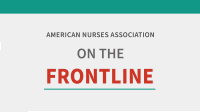Appropriate staffing is achievable.


Appropriate staffing: “A dynamic process that aligns the number of nurses, their workload, expertise, and resources with patient needs in order to achieve quality patient outcomes within a healthy work environment.”
– Nurse Staffing Task Force
Achieving and maintaining appropriate staffing has been a rallying cry for decades within the nursing profession and healthcare. The destructive COVID-19 pandemic only deepened underlying chronic work environment challenges at the root of our staffing woes, ramping up urgency to find sustainable solutions.
Historically, the American Nurses Association (ANA) has supported nurse-driven staffing committees, which promote flexible staffing levels (hubs.ly/Q01St17V0). Ideally, this approach empowers nurses themselves to determine how many nurses are needed for each shift to care for patients ethically, in accordance with our nursing process and scope and standards of practice. In reality, however, organizations willingness to staff to committees recommendations has been uneven.
Staffing solutions across units, departments, facilities, and even states aren’t a one-size-fits-all proposition. Recognizing these variations, the 2022 ANA Membership Assembly approved a recommendation that ANA supports safe patient standards including ratios that are acuity and setting-specific as per nursing assessment and enforceable. This change broadens our position to align with all of our constituent and state nurses associations, which have pursued different legislative and regulatory approaches to achieve enforceable safe standards. Fundamentally, ANA supports all nurses in advocating for the solutions they find most suitable in their practice settings.
Ratio is a charged and controversial word in the context of nurse staffing solutions. Regardless of how they’re developed or what they’re called, staffing plans always create a ratio. One common metric, hours-per-patient day, boils down to a ratio of nurses to patients, albeit a number typically established in top-level budgets with limited input from direct care nurses.
ANA supports minimum nurse patient ratios as one tool for achieving appropriate staffing. Many alternatives exist, but all should rely on nurses uncontested skill, clinical expertise, and insights into key variables.
In 2022, as part of the Partners for Nurse Staffing Think Tank, ANA put forth more than 150 actionable strategies, implementable within 12 to 18 months, to address the nurse staffing crisis (hubs.ly/Q01St1fc0). In May 2023, the Nurse Staffing Task Force identified another 65 proposed actions involving longer-term timelines (hubs.ly/Q01St1Nq0). These recommendations reflect solutions designed to spur innovation, encourage new care models, and wisely engage the valuable resource of direct care nurses.
The road to achieving appropriate staffing remains arduous, requiring firm commitment and determination from direct care nurses and organizational leaders. This collective effort is essential, however, given the impact on patient safety.
Now is the time to move the dial on staffing. Every single day, nurses in organizations across the United States ration care because theres not enough time for them to do what they know is right. It’s time to end this moral distress by whatever means necessary—staffing committees with direct care nurses, mandated disclosures of staffing levels, or legislated minimum ratios. Hospitals and payors need to engage with nurses openly and directly about the value of nursing and the resources required to deliver care that our patients expect and deserve.
Nurses, the most trusted professionals, should be the most respected in decision-making to achieve appropriate staffing. The stakes for not doing so are high—quite high—for nurses, our patients, and our nation’s health and well-being.


Jennifer Mensik Kennedy,
PhD, MBA, RN, NEA-BC, FAAN, President,
American Nurses Association
American Nurse Journal. 2023; 18(7). Doi: 10.51256/ANJ072313





















2 Comments. Leave new
The issue of the value of nursing (as noted by Dr. Welton) was called out in the Nurse Staffing Task Force recommendations (https://bit.ly/3E0ETaa). ANA has engaged with several groups focused on the “value of nursing” and “nurse reimbursement” topics and has this work currently embedded in our 2023-2025 strategic plan.
Jennifer, I applaud the ANA taking a proactive stand on ratios and reasonable and optimum workload and staffing. As a member of the ANA Nurse Staffing Taskforce, members worked diligently to move forward beyond just ratios and the final document crystalizes our collective call for action.
However, one foundational issue that did not make the final cut, is the financial structure and incentives for hospitals to increase ratios to improve overall financial returns and bottom line. This is a conundrum, there is an urgent need to focus on healthcare finance reforms to take nursing out of room and board and pay for it separately and at an optimum level. If hospitals decrease the amount of nursing care below prudent and safe staffing levels, they should receive less payment for that care.
I am working with a recently formed group the Commission on Nurse Reimbursement to address this issue. I ask ANA to work with us to formulate payment reforms that support the optimum level of nursing care without raising overall heathcare costs. Please take a moment to consider these fundamental changes and articulate a plan in combination with appropriate professional groups, policy makers and legislators. I will be most willing to work with ANA to move this issue forward. John Welton, PhD, RN, Professor Emeritus, University of Colorado College of Nursing